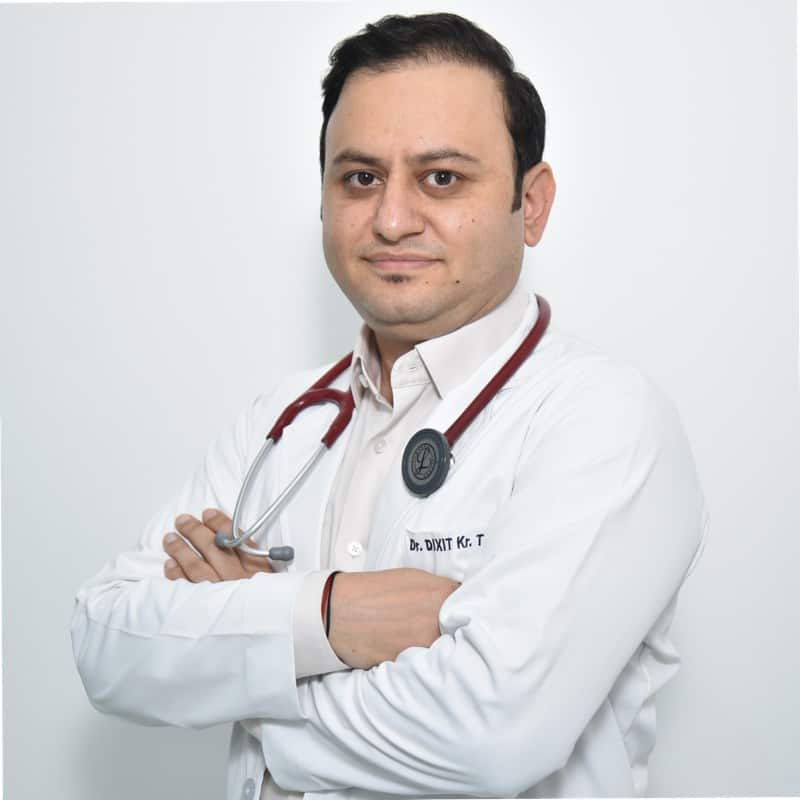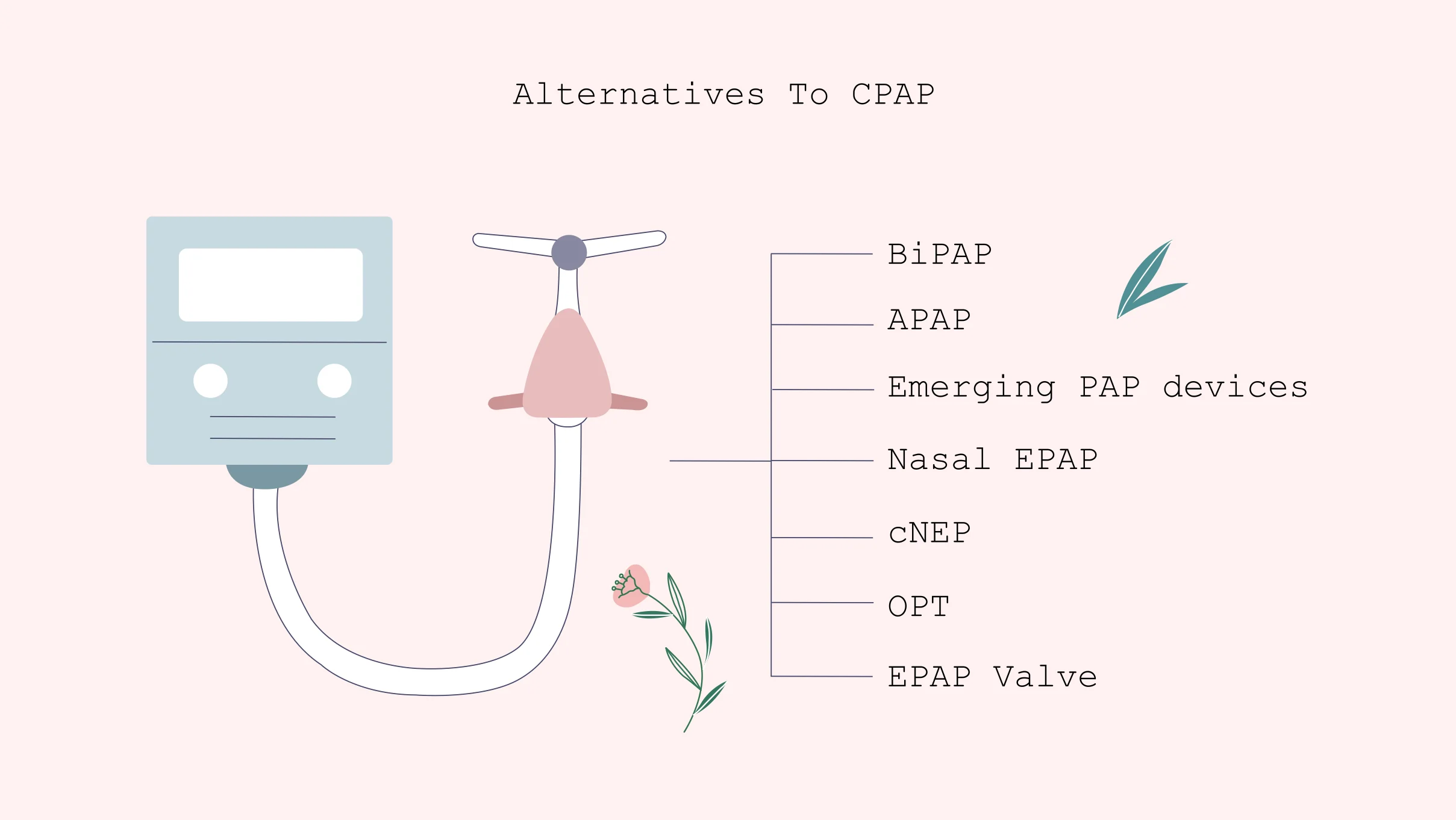Alternatives to CPAP : A Detailed Guide
Written by

Medical reviewed by


While going to sleep looks like a simple chore, it can be difficult for some to master, mainly people who snore or suffer from sleep apnea. Here, the main form of treatment can be a CPAP machine. Continuous positive airway pressure (CPAP) is a machine that prevents any airway obstruction so that your breathing doesn’t get hindered. However, CPAP can be cumbersome as it requires you to wear a mask over your nose and mouth. So, are there any alternatives to CPAP? Yes. Read ahead to know more!
Is CPAP the Only Treatment for Sleep Apnea?
No, there are other treatment options apart from a CPAP machine. They are;
Other Air Pressure Devices
If the CPAP machine continues to cause a problem, you can always opt for other airway pressure devices. However, you must always confirm with your doctor to see what suits you best.
Oral Devices
You can also consult your doctor for Mandibular Advancement Splints (MAS) and Tongue-Retaining Devices (TRDs), which are commonly used oral devices. They are designed to keep the throat open and can also relieve snoring. MAS is a custom-made medical device worn in the mouth whereas TRDs is a customised monobloc oral appliance used in the treatment of OSAS.
Why Use an Alternative to a CPAP Machine?
Some of the reasons why use CPAP alternatives are;
- Cost
One of the main reasons why some may opt for other alternatives when it comes to a CPAP machine is the cost. It costs anywhere from INR 20,000 to INR 1 Lakh rupees.
- Compliance Requirements
Not all private providers in India offer insurance for CPAP machines. However, some offer a sleep apnea plan that includes using a CPAP machine.
- Side Effects
Some may go through the side effects of CPAP machines. For instance, some may find it highly uncomfortable to use. Other side effects include dry mouth, itchy or red eyes, and stuffy or runny nose. Also, some may find the noise disturbing if you sleep with a partner.
- Adherence
The overall adherence rate for CPAP machines may be about 30.3%.
Some of the sleep apnea treatments without CPAP can include lifestyle changes, other devices, and surgery.
Alternatives to CPAP Devices
Some of the alternatives to CPAP for sleep apnea include;
BiPAP
Bilevel-positive airway pressure (BiPAP) is quite similar to CPAP. However, one significant advantage of a BiPAP machine is that it comes with two pressure settings, whereas CPAP comes with only one. And with CPAP, it gets difficult for some to tolerate one single pressure, whereas with BiPAP, there is a different pressure setting for exhalation. But, BiPAP can be expensive, so you must speak with your doctor before making the switch.
APAP
The APAP machine automatically adjusts to your breathing requirements, unlike CPAP. It continuously measures the resistance present in your breathing on a breath-by-breath level. It decreases pressure on your upper airway when the breathing becomes stable and increases when an airway obstruction such as apnea occurs. It can be one of the great alternatives to CPAP for obstructive sleep apnea.
Emerging PAP Devices
A few devices are in the making as an alternative to CPAP machines. However, in 2021 it was seen that IIT Ropar created an alternative for the CPAP machine, which does not require electricity.
Nasal EPAP
Nasal expiratory positive airway pressure (Nasal EPAP) is one of the sleep apnea alternatives to CPAP. These devices have two small valves where air can be drawn through each nostril but cannot be exhaled. These valves are placed using adhesive tabs outside the nose. Some side effects seen during the trial included difficulty breathing, problems with falling or staying asleep, dry mouth and nasal congestion.
cNEP
One of the alternatives to using a CPAP machine is cNEP. Here, unlike the CPAP, this machine applies negative pressure outside the airway where it applies suction to the neck area to ensure the mid-upper airway is blockage free as you enjoy a deep slumber.
In a 2019 study, it was seen that cNEP showed a 50% reduction in apnea symptoms and was also concluded saying that cNEP can be an effective treatment method for obstructive sleep apnea. So, if you are looking for sleep apnea treatment without CPAP, you can ask your doctor about cNEP.
OPT
Oral pressure therapy (OPT) is less invasive than a CPAP mask. Here, a machine and a mouthpiece exert negative pressure in the mouth to slide the tongue and the mouth palate slightly forward. However, this device may not be suitable for all as it was seen that some patients only saw an average reduction in apnea events.
Expiratory Positive Airway Pressure (EPAP) Valve
EPAP valves are small devices attached to the nostrils to help you breathe. These valves work in a way that the pressure exerted as you exhale keep the airways open as you inhale. However, they cannot provide pressure when you breathe in like a CPAP machine would. That said, in one analysis of studies, it was seen that EPAP reduced sleep apnea and snoring events significantly.
Lifestyle Changes as a CPAP Alternative
Despite using or not using a machine, there are other things you can do to reduce your sleep apnea events. A few lifestyle changes can make all the difference.
Exercise and Weight Loss
While OSA can occur due to high blood pressure and narrowed airways, there is a strong link between obesity and sleep apnea. Being obese leads to fat deposits around the neck, which can obstruct the airways. Therefore, weight loss can be highly beneficial to OSA and reduce the disorder’s severity.
In one study, bariatric surgery was seen as beneficial for OSA as it can eliminate excess fat. However, you must speak with your doctor for more information and the right guidance. If you are struggling with weight loss, you can also consult a nutritionist for the right diet and exercise plan to help you out.
Experiment With Your Sleeping Position
Sleeping on your back or in a supine position is not ideal for people with sleep apnea. Here, sleeping on your side with your back straight is best. Why? Because when you sleep on your back, the tongue and the larynx can block the airways and obstruct your breathing. In fact, one study even found that 62% of people with sleep apnea had supine-predominant sleep apnea, which is the dominant phenotype of the OSA syndrome.
Devices can benefit patients suffering from OSA by alerting them when they go back to sleeping on their backs. It can reduce the number of sleep apnea events.
Quit Smoking
Smoking is one of the leading causes of obstructive sleep apnea. In a 2014 study, it was seen that smoking regularly aggravates the condition by hampering the natural sleep rhythm, causing inflammation of the upper airways, narrowing the muscles of the respiratory system, and curbing your potential to wake up naturally.
Another study from 2019 also showed that smokers experienced more sleep apnea events, which can lead to blood oxygen levels falling and excessive daytime sleepiness. When you quit smoking, OSA may not completely vanish, but you will see a major difference in your sleep quality and notice fewer sleep apnea events.
If you cannot quit this habit, speak with your doctor, as there are treatment plans for the same.
Avoid Alcohol
A glass of wine may sound good after a long day at work, but it is not a good idea for someone with sleep apnea. Consuming alcohol disrupts your sleep as it prevents the brain from entering REM sleep. Also, when you drink alcohol, there are chances that the throat muscles relax when you snooze, blocking the airways. In a 2018 review of the studies, it was seen that alcohol consumption had longer and more sleep apnea events. Therefore, when you cut alcohol or reduce its consumption drastically, you will notice a difference.
Other CPAP Alternatives
If you are looking for non-CPAP treatment methods, here are a few other alternatives that can help you out. However, it is essential to always speak with your doctor before you make any changes.
Tongue-Retaining Devices
Tongue-retaining devices (TRD) are small mouthpieces touted as an alternative to CPAP. TRD ensures your tongue remains forward and keeps it that way so it doesn’t slide back when you are asleep. In a 2017 meta-analysis, it was found that while TRDs can help prevent a few sleep apnea events, it doesn’t come close to the effectiveness of a CPAP machine. Therefore, TRD may not be the right option for you if you are someone with severe OSA. However, you can consult your doctor for more.
Orofacial Therapy
Orofacial therapy can be categorised as physical therapy for the mouth to treat snoring and mild to moderate OSA. Here, a therapist can prescribe exercises for 6 to 12 months. When used along with CPAP, it was seen that orofacial therapy can be effective in reducing apnea events.
Surgery
Surgery may also be one of the options for people suffering from sleep apnea. Depending on the conditions, a few adjustments may be made to the soft palate, pharyngeal tissues, jaw and tonsils. However, surgery may not be suitable for all.
CPAP is one of the best treatment methods available for obstructive sleep apnea. However, for some, it can be cumbersome and also difficult to use regularly. If you are struggling with CPAP therapy, talk to your doctor about alternatives to CPAP to help you out.
people like this article
Written by

Medical reviewed by








